HONDA ODYSSEY 1997 User Guide
Manufacturer: HONDA, Model Year: 1997, Model line: ODYSSEY, Model: HONDA ODYSSEY 1997Pages: 241, PDF Size: 2.52 MB
Page 11 of 241
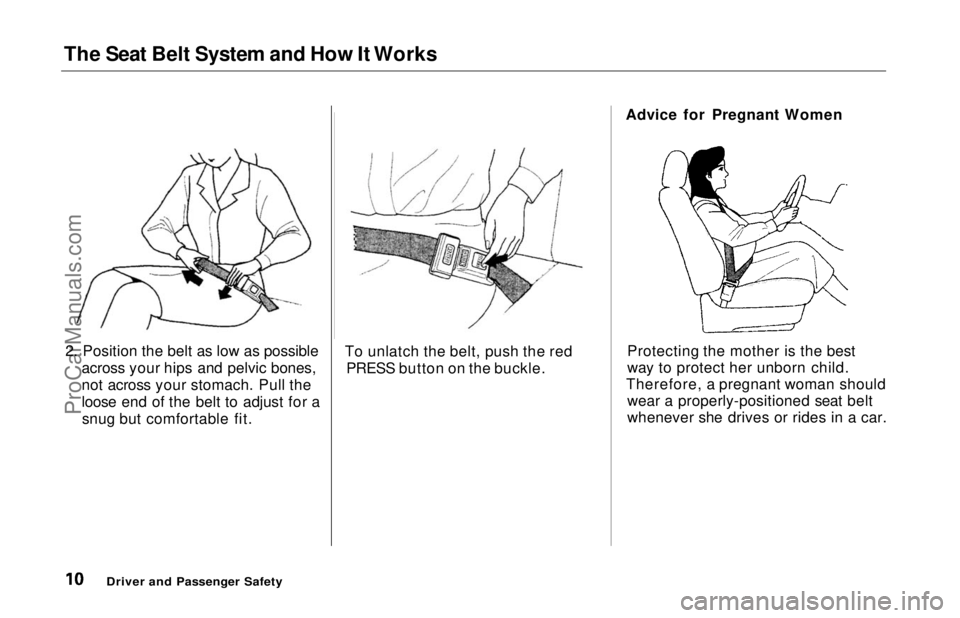
The Seat Belt System and How It Works
2. Position the belt as low as possible across your hips and pelvic bones,
not across your stomach. Pull the
loose end of the belt to adjust for asnug but comfortable fit. To unlatch the belt, push the red
PRESS button on the buckle. Advice for Pregnant Women
Protecting the mother is the best
way to protect her unborn child.
Therefore, a pregnant woman should wear a properly-positioned seat belt
whenever she drives or rides in a car.
Driver and Passenger SafetyProCarManuals.comMain Menu Table of Contents s t
Page 12 of 241

The Seat Belt System and How It Works
If possible, use a lap/shoulder seat
belt, remembering to keep the lap
portion as low as possible (see page
7).
Each time you have a check-up, ask
your doctor if it's okay for you to drive and how you should position a
lap/shoulder seat belt. Seat Belt Maintenance
For safety, you should check the
condition of your seat belts regularly.
Pull out each belt fully and look for
frays, cuts, burns, and wear. Check
that the latches work smoothly and
the lap/shoulder belts retract easily.
Any belt not in good condition or not working properly should be replaced.
If a seat belt is worn during a crash,
have your dealer replace the belt and inspect the anchors for damage.
For information on how to clean your
seat belts, see page 189 .
Driver and Passenger SafetyProCarManuals.comMain Menu Table of Contents s t
Page 13 of 241

Supplemental Restraint System
Your car is equipped with a Supple- mental Restraint System (SRS) to
help protect the head and chest of
the driver and front seat passenger during a severe frontal collision.
This system does not replace your seat
belts. It supplements, or adds to, the
protection offered by seat belts and
other occupant protection features.
SRS Components
Your supplemental restraint system
includes:
One airbag in the steering wheel
for the driver and another in the dashboard for the passenger. Sensors that can detect a severe
frontal collision. A sophisticated electronic system
that continually monitors thesensors, control unit, airbag
activators, and all related wiring
when the ignition is ON (II). An indicator light on the instru-
ment panel to alert you to a possi-
ble problem with the system. Emergency backup power in case
your car's electrical system is disconnected in a crash. What Happens In a Crash
If you ever have a severe frontal
collision, the sensors will detect
rapid deceleration and signal the
control unit to instantly inflate the
airbags.
During a crash, your seat belts will
help to restrain your lower body and
torso. The airbags will provide a cushion to absorb crash energy and
help keep the head and chest of the driver and front passenger from
striking the interior of the car.
After inflating, the airbags will immediately deflate. The entire
process, from detection to deflation,
takes a fraction of a second. This
process occurs so quickly that you may not hear the loud noise created
by the airbag inflators, or realize
what has happened.
Driver and Passenger Safety
Not wearing a seat belt
increases the chance of serious
injury or death in a crash, even
if you have airbags.
Be sure you and your
passengers always wear seat
belts and wear them properly.ProCarManuals.comMain Menu Table of Contents s t
Page 14 of 241
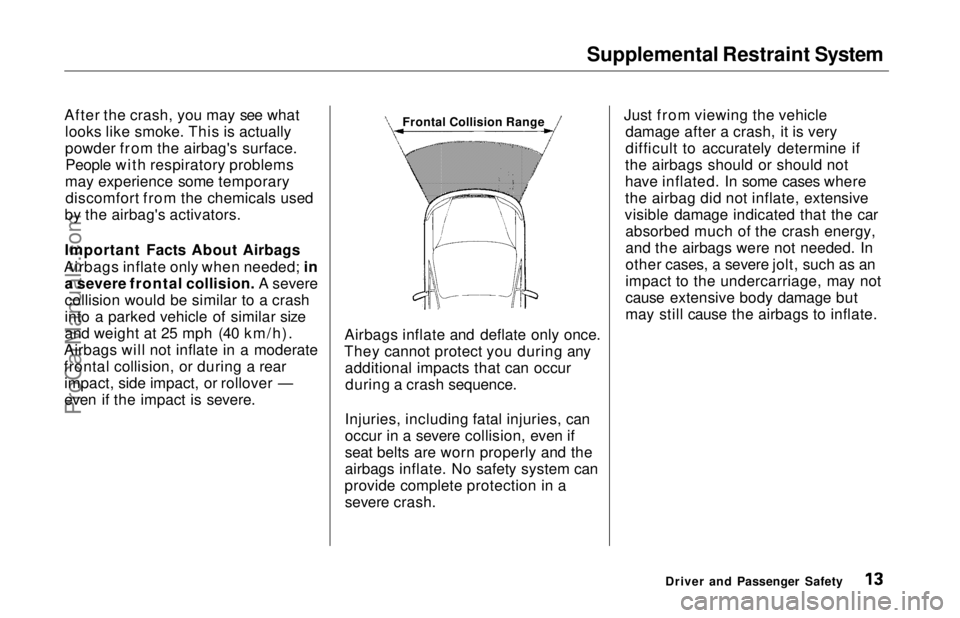
Supplemental Restraint System
After the crash, you may see what looks like smoke. This is actually
powder from the airbag's surface.People with respiratory problems
may experience some temporary discomfort from the chemicals used
by the airbag's activators.
Important Facts About Airbags
Airbags inflate only when needed; in a severe frontal collision. A severe
collision would be similar to a crash
into a parked vehicle of similar size
and weight at 25 mph (40 km/h).
Airbags will not inflate in a moderate
frontal collision, or during a rear impact, side impact, or rollover —
even if the impact is severe. Airbags inflate and deflate only once.
They cannot protect you during any additional impacts that can occurduring a crash sequence.
Injuries, including fatal injuries, can
occur in a severe collision, even if
seat belts are worn properly and the
airbags inflate. No safety system can
provide complete protection in a severe crash. Just from viewing the vehicle
damage after a crash, it is very
difficult to accurately determine if
the airbags should or should not
have inflated. In some cases where
the airbag did not inflate, extensive
visible damage indicated that the car absorbed much of the crash energy,
and the airbags were not needed. In
other cases, a severe jolt, such as an
impact to the undercarriage, may not
cause extensive body damage but
may still cause the airbags to inflate.
Driver and Passenger Safety
Frontal Collision RangeProCarManuals.comMain Menu Table of Contents s t
Page 15 of 241
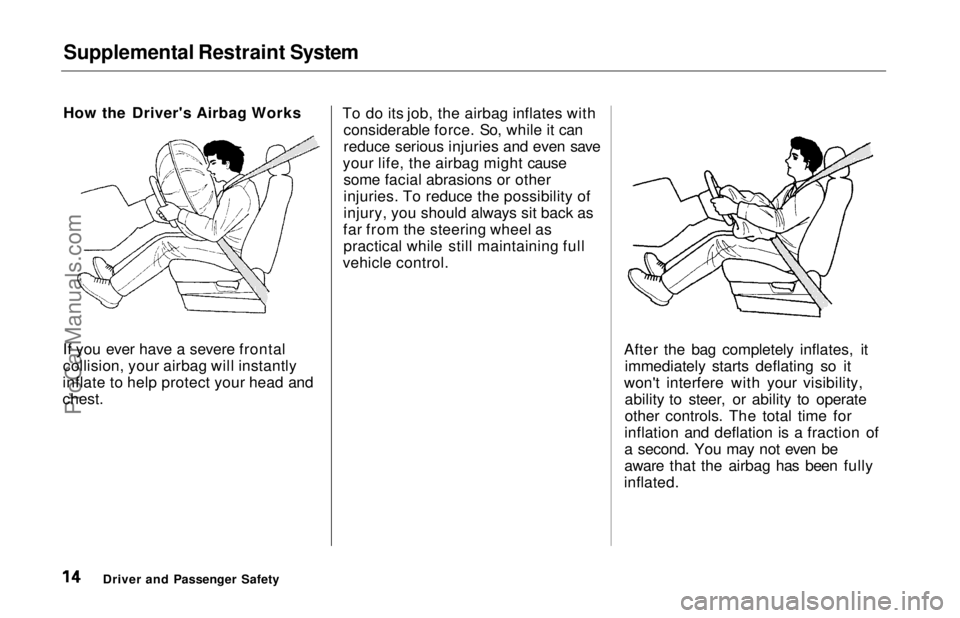
Supplemental Restraint System
How the Driver's Airbag Works
If you ever have a severe frontal
collision, your airbag will instantly
inflate to help protect your head and
chest. To do its job, the airbag inflates with
considerable force. So, while it can
reduce serious injuries and even save
your life, the airbag might cause some facial abrasions or other
injuries. To reduce the possibility of
injury, you should always sit back as
far from the steering wheel as practical while still maintaining full
vehicle control.
After the bag completely inflates, itimmediately starts deflating so it
won't interfere with your visibility, ability to steer, or ability to operate
other controls. The total time for
inflation and deflation is a fraction of
a second. You may not even be
aware that the airbag has been fully
inflated.
Driver and Passenger SafetyProCarManuals.comMain Menu Table of Contents s t
Page 16 of 241
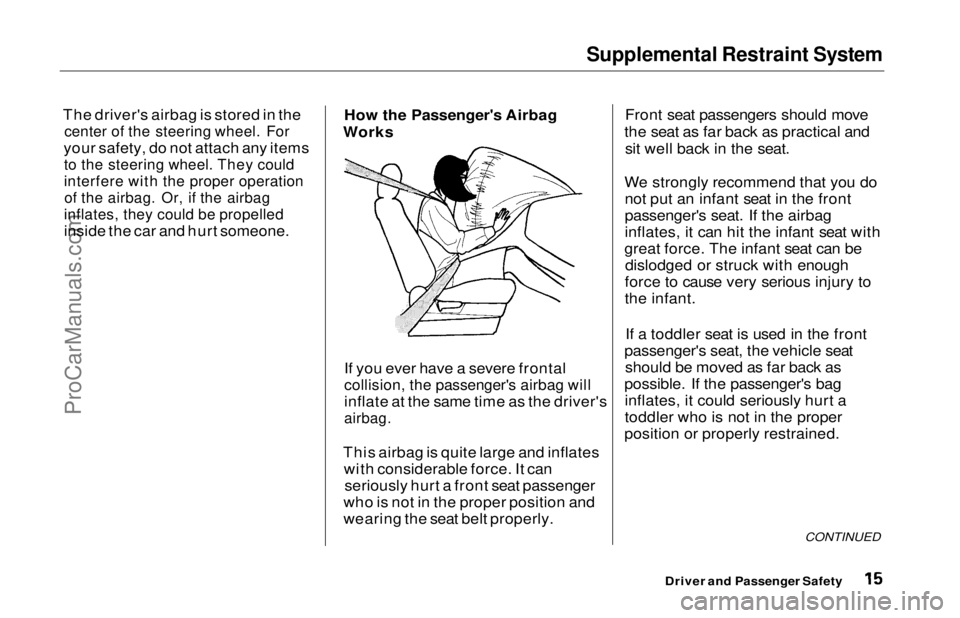
Supplemental Restraint System
The driver's airbag is stored in the
center of the steering wheel. For
your safety, do not attach any items
to the steering wheel. They could
interfere with the proper operation
of the airbag. Or, if the airbag
inflates, they could be propelled
inside the car and hurt someone. How the Passenger's Airbag
Works
If you ever have a severe frontal
collision, the passenger's airbag will
inflate at the same time as the driver's
airbag.
This airbag is quite large and inflates with considerable force. It canseriously hurt a front seat passenger
who is not in the proper position and
wearing the seat belt properly. Front seat passengers should move
the seat as far back as practical and sit well back in the seat.
We strongly recommend that you do not put an infant seat in the front
passenger's seat. If the airbag
inflates, it can hit the infant seat with
great force. The infant seat can be dislodged or struck with enough
force to cause very serious injury to
the infant.
If a toddler seat is used in the front
passenger's seat, the vehicle seat should be moved as far back as
possible. If the passenger's bag inflates, it could seriously hurt a
toddler who is not in the proper
position or properly restrained.
CONTINUED
Driver and Passenger SafetyProCarManuals.comMain Menu Table of Contents s t
Page 17 of 241
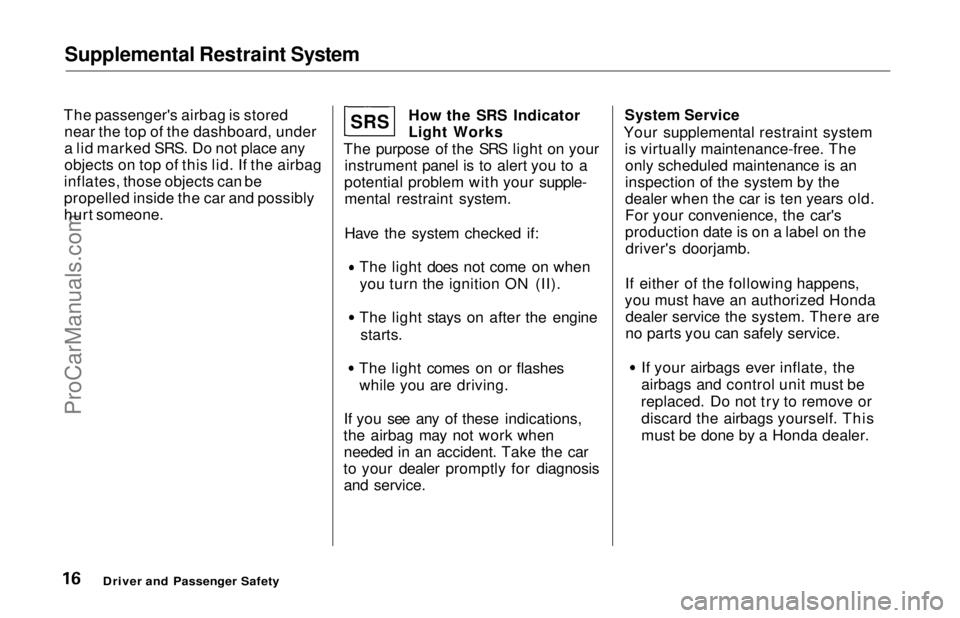
Supplemental Restraint System
The passenger's airbag is stored near the top of the dashboard, under
a lid marked SRS. Do not place any
objects on top of this lid. If the airbag
inflates, those objects can be
propelled inside the car and possibly
hurt someone. How the SRS Indicator
Light Works
The purpose of the SRS light on your instrument panel is to alert you to a
potential problem with your supple- mental restraint system.
Have the system checked if: The light does not come on when
you turn the ignition ON (II). The light stays on after the engine
starts. The light comes on or flashes
while you are driving.
If you see any of these indications,
the airbag may not work when needed in an accident. Take the car
to your dealer promptly for diagnosis and service.
System Service
Your supplemental restraint system is virtually maintenance-free. Theonly scheduled maintenance is an
inspection of the system by the
dealer when the car is ten years old.
For your convenience, the car's
production date is on a label on thedriver's doorjamb.
If either of the following happens,
you must have an authorized Honda dealer service the system. There are
no parts you can safely service. If your airbags ever inflate, the
airbags and control unit must be
replaced. Do not try to remove or discard the airbags yourself. This
must be done by a Honda dealer.
Driver and Passenger Safety
S R S
ProCarManuals.comMain Menu Table of Contents s t
Page 18 of 241

Supplemental Restraint System
If the SRS indicator light alerts
you to a problem, have the supplemental restraint system
inspected as soon as possible. If
you ignore this indication, the airbags might not inflate when you
need them. System Service Precautions
Do not modify your steering wheel
or any other part of the supplemental
restraint system. Modifications could
make the system ineffective.
Do not tamper with the system's
components or wiring. This could cause the airbags to inflate inadver-
tently, possibly injuring someone
very seriously.
Tell anyone who works on your car that you have a supplemental
restraint system. Failure to follow
the procedures and precautions in
the official Honda service manualcould result in personal injury ordamage to the system. Scrapping an entire car that has
uninflated airbags can be dangerous.
Get assistance from a Honda dealer
if your car must be scrapped.
If you sell your car, please be sure to
tell the new owner that the car has a supplemental restraint system. Alert
them to the information and precau- tions in this part of the owner's
manual.
Driver and Passenger SafetyProCarManuals.comMain Menu Table of Contents s t
Page 19 of 241
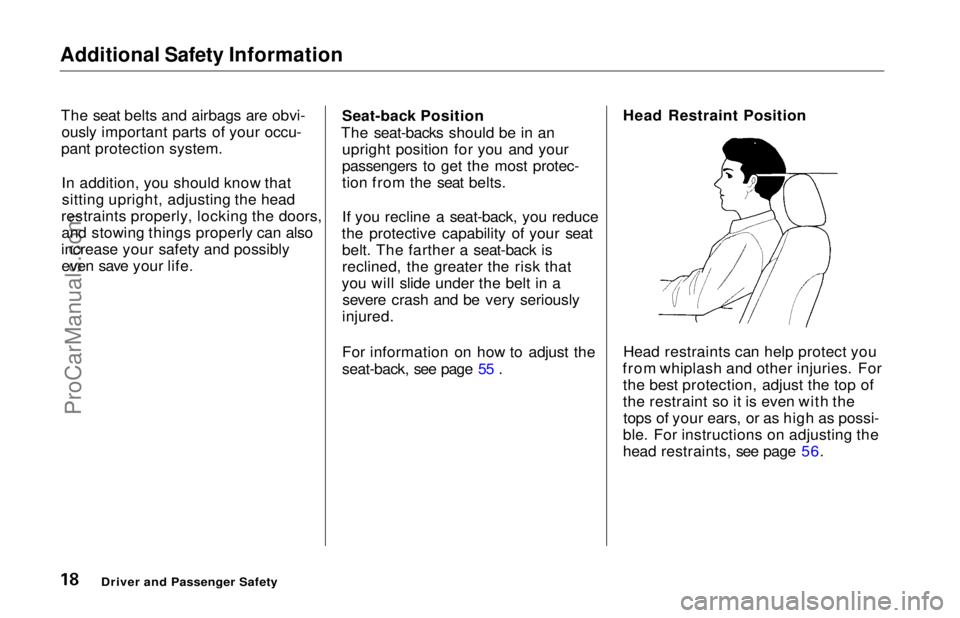
Additional Safety Information
The seat belts and airbags are obvi-ously important parts of your occu-
pant protection system.
In addition, you should know thatsitting upright, adjusting the head
restraints properly, locking the doors, and stowing things properly can also
increase your safety and possibly even save your life. Seat-back Position
The seat-backs should be in an upright position for you and your
passengers to get the most protec-
tion from the seat belts.
If you recline a seat-back, you reduce
the protective capability of your seat belt. The farther a seat-back is
reclined, the greater the risk that
you will slide under the belt in a severe crash and be very seriously
injured.
For information on how to adjust the
seat-back, see page 55 . Head Restraint Position
Head restraints can help protect you
from whiplash and other injuries. For the best protection, adjust the top of
the restraint so it is even with thetops of your ears, or as high as possi-
ble. For instructions on adjusting the
head restraints, see page 56.
Driver and Passenger SafetyProCarManuals.comMain Menu Table of Contents s t
Page 20 of 241

Additional Safety Information
Door Locks
It is not safe to leave your car doors
unlocked. A passenger, especially a
child, could open a door and acci- dentally fall out. Also, there is a
greater chance of being thrown out of the car during a crash when the
doors are not locked.
Storing Cargo Safely
Before you drive, make sure you
first securely store or tie down any
items that could be thrown around
the car and hurt someone, or
interfere with your ability to operate
the controls.
Be sure to keep compartment doors
closed when the car is moving. If a
front passenger hits the door of an open glove box, for example, he
could injure his knees.
For information on loading cargo,
see page 116. Driving with Pets
Loose pets can be a hazard while you
are driving. An unrestrained pet can
interfere with your ability to drive
the car. In a crash or sudden stop, loose pets or cages can be thrownaround inside the car and hurt you or
your passengers. It is also for their safety that pets should be properly
restrained in your car.
The recommended way to restrain a medium-sized or larger dog is with aspecial traveling harness. This har-
ness can be secured to the rear seat
with a seat belt. Travel harnesses are available at pet stores.
A small dog, cat, or other small animal will be safest in a pet carrier
with rigid sides. Choose a style that allows you to secure it to the car's
seat by routing a seat belt through
the carrier's handle. For further information, contact your
veterinarian or local animal protec- tion society.
Driver and Passenger SafetyProCarManuals.comMain Menu Table of Contents s t